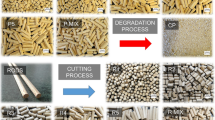Abstract
At hand of a simplified model, a theory has been developed in order to gain more insight in the complicated mechanism behind the functioning of vibratory conveyors in both, qualitative and quantitative sense. The theoretical results have been basely presented in one graph only, which forms a useful aid for design engineers and estimators. The theoretical results have been experimentally checked by means of two special designed conveyors, and by making use of the equipment of a laboratory of a major manufacturer in the field of bulk solids handling and transportation. The theory also covers the cases of inclined and declined transport. In this work, however, the latter has not been discussed since no experimental results were available yet for comparison.
Similar content being viewed by others
References
Böttcher, S.: Beitrag zur Klärung der Gutbewegung auf Schwingrinnen. Fördern und Heben 8 (1958), Nr. 3, Nr. 4, Nr. 5, S. 127–131, S. 235–204, S. 307–315.
Berry, P.E.: Basic theory of low-acceleration oscillating conveyors. Journal of Agricultural Engineering Research 4 (1959) p. 204–213.
Wehmeier, K.H.: Untersuchungen zum Fördervorgang auf Schwingrinnen. Fördern und Heben 11 (1961) Nr. 5, S. 317–327/375–384.
Weese, W.: Beitrag zur Berechnung von Schwing-förderern unter Berücksichtigung der zwischen Gut und Rinne auftretenden Reibung. Wissenschaftliche Zeitschrift der technischen Hochschule Otto von Guericke Magdeburg 7 (1963) Nr. 3-4, S. 283–304.
Düring, K.: Berechnung der Amplituden von elektrodynamischen Förderrinnen mit gerichteten Schwingungen. Fördern und Heben 13 (1963), Nr. 10 und 11, S. 747–751/797–801.
Booth, J.H. andMcCallion, H.: On predicting the mean conveying velocity of a vibratory conveyor. Proc. Instn. Mech. Eng. Vol. 178, Pt 1, Nr. 20, (1963–64) p. 521–538.
Wehmeier, K.H.: Schwingförderrinnen—Eine Systematik der Bauformen und ihre Eigenarten. Fördern und Heben 14 (1964) Nr. 3, S. 155–161.
Axt, W.: Unter- und überkritisch arbeitende Schwing-förderer und Schwingsiebe in Gebäuden und Konstruktionen und deren Schwingungssisolierung. Sonderdruck aus VDI-Berichte 88/1965, S. 27–32.
Axt, W.: Bauformen und Einsatzbeispiele von Schwingrinnen und Schwingsieben. Aufbereitungs-Technik (1967), Nr. 3, S. 138–145.
Redford, A.H. andBoothroyd, G.: Vibratory feeding. Proc. Instn. Mech. Eng. 182 (1967–68) No. 6, p. 135–145.
Gaberson, H.A.: Material transport on oscillating conveyors. Ph.D. Thesis Massachusetts Institute of Technology (1967).
Thelen, G.: Beitrag zur dynamischen Berechnung von überkritisch abgestimmten Schwingförderern mit Unwuchtantrieb. Hebezeuge und Fördermittel 9 (1969) Nr. 12, S. 357–362.
Peschl, I.A.S.Z.: Einfluß der Guteigenschaften auf die Fördergeschwindigkeit bei der Förderung auf Schwingrinnen. Fördern und Heben 20 (1970) Nr. 8, S. 442–447.
Thelen, G.: Auswahl der Schwingförderer aus der Sicht des Erreger- und des Schwingsystems. Hebezeuge und Fördermittel 10 (1970) Nr. 3, S. 65–70.
Krause, R.: Grundbegriffe der Schwingungstechnik. Chemiker-Zeitung 95 (1971) Nr. 8, S. 364–372.
Fechner, G. undHanemann, S.: Magnetvibration mit 25 Hz Betriebsfrequenz. Techn. Mitt. AEG-Telefunken 61 (1971) Nr. 3, S. 165–168.
Thelen, G.: Berechnung und Gestaltung von Schwingförderern mit Unwuchterregung und resonanznaher Abstimmung. Hebezeuge und Fördermittel 13 (1973) Nr. 1, S. 3–7.
Borg, L. ter: Determination of the average conveying speed of bulk solid material on vibratory conveyors. Master thesis, Univ. of Twente, Enschede, The Netherlands 1974, (in Dutch).
Algra, C.A.: Measurements of conveying speed on vibratory conveyors. Bacc. thesis, Univ. of Twente, Enschede, The Netherlands 1976, (in Dutch).
Pajer, G.;Kuhnt, H. undKurth, F.: Stetigförderer. Berlin: VEB Verlag Technik, 1977.
Cornelissen, J.J.M.: Determination of the average conveying speed on a vibratory conveyor. Master thesis, Univ. of Twente, Enschede, The Netherlands, 1978, (in Dutch).
Braakman, G.: Determination of the transportation efficiency of a vibratory conveyor having a elliptical mode of vibration, Univ. of Twente, Enschede 1978, The Netherlands, (in Dutch).
Steinbrück, K.: Zur Fördergutrückwirkung auf Schwingrinnen. Dissertation, TU Hannover 1980.
La Maire, M.: Experimental determination of the velocity efficiency of a point mass on a sliding vibratory conveyor having an elliptical mode of vibration. Univ. of Twente, Enschede, The Netherlands 1981, (in Dutch).
Colijn, H.: Mechanical conveyors for bulk solids. Elsevier 1985.
Keller, J.M.: Impact with friction. Journal of Applied Mechanics, Vol. 53 (1986).
Rademacher, F.J.C. andBorg, L. ter: Handout Vibratory Conveyors. Revised version (1986), Univ. of Twente, The Netherlands, (in Dutch).
Ng, K.L.; Ang, L.A. andChng, S.C.: A computer model for vibrating conveyors. Proc. Instn. Mechanical Engineers, Vol. 200 (1986).
Woodcock C.R. andMason, J.S.: Bulk solids handling. Leonard Hill 1987.
Erdesz, K. andSzalay, A.: Experimental study on the vibrational Transport of bulk solids. Powder Technology, Vol. 55 (1988).
Erdesz, K. andNémeth, J.: Methods of calculation of vibrational transport rate of granular material. Powder Technology, Vol. 55 (1988).
Hota, S.P. andKarmaker, R.: Optimalisation studies on vibratory conveyors. Bulk Solids Handling, Vol. 8 (1988) No. 6.
Brach, R.M.: Rigid body collisions. Journal of Applied Mechanics, Vol. 56 (1989).
Nedderman, R.M. andHarding, G.L.H.: The flight-free vibrating conveyor, part 1 and 2. Trans. Instn of Chem. Engineers, Vol. 68, Part A (1990).
Socha, H. undKoltze, K.: Berechnungsverfahren zur theoretischen Analyse des Bewegungsverhalten von Schwingfördersystemen. Maschinenbautechnik 1990.
Kappel, J.M. van: Measurement of dampening of bulk solids. Master thesis, Univ. of Twente, Enschede, The Netherlands 1991, (in Dutch).
Sloot, E.M.: Theoretical and experimental investigation on bulk solid transportation with inclined vibratory conveyors. Master thesis, Univ. of Twente, Enschede, The Netherlands 1992, (in Dutch).
Rex Carrier, (manufacturer): Brochures and internal reports on vibratory equipment. Fern Valley Road, Louisville, Kentucky, U.S.A.
Author information
Authors and Affiliations
Rights and permissions
About this article
Cite this article
Rademacher, F.J.C., ter Borg, L. On the theoretical and experimental conveying speed of granular bulk solids on vibratory conveyors. Forsch Ing-Wes 60, 261–283 (1994). https://doi.org/10.1007/BF02601316
Received:
Issue Date:
DOI: https://doi.org/10.1007/BF02601316




